How to Find Ticks on Dogs: A Step-by-Step Guide for Pet Owners
Ticks pose a significant threat to the health and well-being of our beloved dogs. These tiny arachnids can transmit Lyme disease, ehrlichiosis, anaplasmosis, and more. Therefore, it is crucial for pet owners to be vigilant and regularly check their dogs for ticks. Early detection and removal of ticks are essential to minimize the risk of disease transmission. One of the challenges with ticks is their small size. Some ticks can be as tiny as a pinhead, making them difficult to spot with a glance. They can easily hide in your dog’s fur, making a thorough search necessary. This step-by-step guide will walk you through finding ticks on your furry friend, ensuring their safety and preventing potential health issues.

How to Prepare for a Tick Check
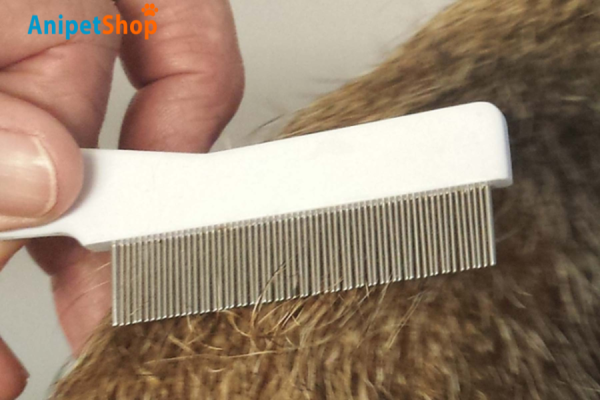
Before you begin the tick check on your dog, it’s essential to gather the necessary supplies below:
- Fine-tooth comb: A comb with closely spaced teeth, such as a flea comb, works well for parting your dog’s fur and searching for ticks. The fine teeth can help you detect even the most minor ticks.
- Magnifying glass (optional): If you have a magnifying glass or a similar tool, it can help look closely at any suspicious spots or ticks you find. This can help you confirm their presence and identify them more accurately.
- Rubbing alcohol, tweezers, or tick removal tool: If you find a tick during the examination, you’ll need a safe and effective way to remove it. Prepare rubbing alcohol to disinfect the area after tick removal. Use fine-tipped tweezers specifically designed for tick removal or a tick removal tool, ensuring you have a firm grip on the tick and can remove it without leaving any mouthparts behind.
- Container: Have a small container with a secure lid on hand. This will allow you to safely store any ticks you find for identification purposes or show them to your veterinarian if necessary.
Keeping your dog secure during the tick check is essential to ensure their cooperation and prevent them from wandering off. Use a leash or have someone assist you in holding your dog gently but securely. Choose a well-lit area to conduct the examination. Natural light is ideal, so consider performing the tick check in a room with ample sunlight or outdoors during the daytime. Good lighting will help you spot ticks more efficiently and ensure a thorough inspection. Gathering the necessary supplies and creating an appropriate environment will prepare you to conduct a comprehensive tick check on your dog. Remember to approach the process calmly and patiently, rewarding your dog for cooperation throughout the examination.
Where to Look for Ticks on Dogs
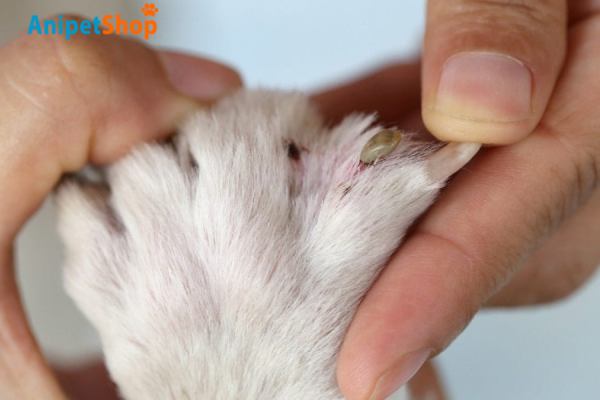
Ticks can attach themselves to various areas on your dog’s body. Here are the key areas to focus on during your tick check:
- In and around ears: Ticks are often attracted to the warm and hidden folds of your dog’s ears. Inspect the inner folds and behind the ears, feeling for any small bumps or irregularities.
- Around eyes, eyelids, and face: Carefully examine the area around your dog’s eyes, including the eyelids and the fur around them. Ticks can hide in these areas, so be thorough in your inspection.
- Under collar or harness: Ticks can latch onto the collar or harness, especially if they come into contact with vegetation or brush while your dog is outside. Lift the collar or harness and check underneath it for any ticks.
- Under front legs (armpits): Ticks are drawn to areas with less fur and thinner skin. Lift your dog’s front legs and inspect the armpits, feeling for any bumps or ticks attached to the skin.
- Between toes (including pads): Ticks can hide between your dog’s toes, where it’s warm and protected. Take the time to separate the toes and examine between them, including the paw pads. Look for any small dark spots or ticks attached to the skin.
- Around the groin and tail area: Ticks are attracted to warm and concealed areas such as the groin and tail region. Carefully inspect these areas, parting the fur and checking for any ticks attached to your dog’s skin.
It’s important to note that ticks can be found anywhere on your dog’s body, so a thorough examination is necessary. While these primary areas are typical hotspots, ticks can also attach themselves in other locations. Be diligent and check your dog’s entire body, including the neck, chest, back, belly, and legs.
The Tick Check Technique
To effectively and thoroughly check your dog for ticks, it is recommended to use a combined approach of feeling and looking. This approach allows you to detect ticks through tactile sensation and visual inspection. Here’s how you can perform the tick check technique:
Use your fingertips to feel along your dog’s skin gently:
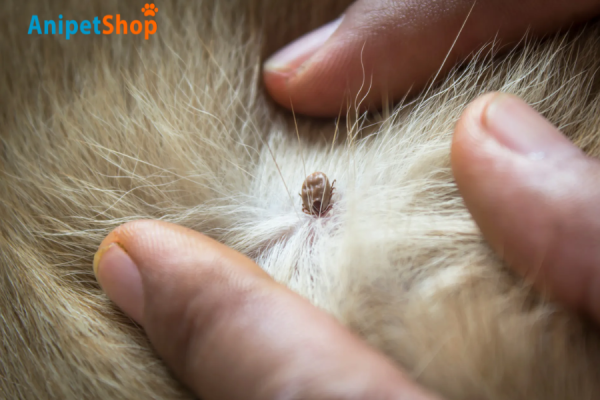
Begin by running your fingertips through your dog’s fur, feeling for small bumps or irregularities. Ticks can feel like tiny scabs or small raised bumps on the skin. Pay close attention to the primary areas mentioned earlier, such as the ears, eyes, collar area, armpits, between the toes, groin, and tail. Part the fur as you go along, especially in areas where the fur is dense or long. This helps expose the skin and allows you to feel for ticks more easily.
Visually examine areas you’ve felt and use a comb:

After using your fingertips to feel for ticks, visually inspect the areas where you detected any bumps or suspicious spots. Take a closer look at the skin by using a fine-tooth comb. Comb through the fur against the direction of hair growth to get a better view of the skin. The comb can help expose hidden ticks and separate the fur, making spotting any crawling or attached ticks on the skin easier. If needed, use a magnifying glass to aid in spotting very small ticks. The magnifying glass can enhance your vision and help you identify ticks that may be difficult to see with the naked eye.
Combining the tactile sensation of feeling for bumps and the visual inspection of the skin increases the chances of detecting ticks during the examination. This method allows you to search thoroughly and ensures that even the most minor ticks are not missed.
Remember to proceed slowly and methodically, working your way from one area to another. If you find a tick during the examination, follow the procedure using tweezers or a tick removal tool. This ensures that you remove the tick entirely and disinfect the area afterwards. By following this tick check technique, you can effectively identify and remove ticks from your dog, reducing the risk of tick-borne diseases and keeping your furry friend safe and healthy.
What to Look For
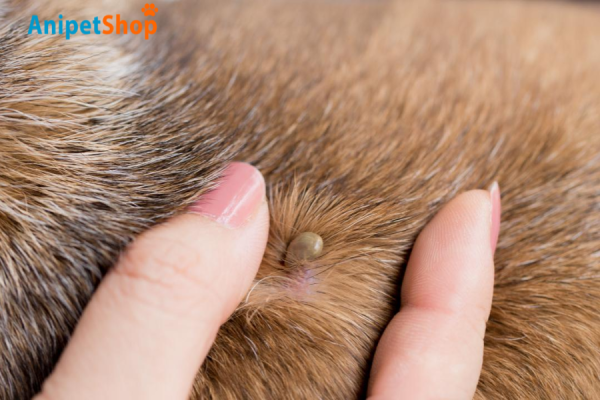
Ticks can vary in appearance, and understanding their characteristics can help you identify them during a tick check. Here are vital factors to consider when searching for ticks on your dog:
- Size: Ticks come in different sizes depending on their life stage and whether they have been fed. Unfed ticks can be as small as a sesame seed, making them difficult to spot with the naked eye. However, if a tick has fed and become engorged with blood, it can grow to the size of a plump grape. Awareness of ticks’ size range will help you identify them at various life cycle stages.
- Color: Ticks can exhibit different colors based on their species and life stage. Standard colors include brown, black, and reddish hues. The specific coloration can depend on the tick species and whether it has recently been fed or is in the process of feeding. Understanding the color variations can assist you in distinguishing ticks from other skin irregularities.
During the tick check, look for small, dark, or irregularly shaped objects attached to your dog’s skin. Ticks will be firmly attached, and their bodies may be partially or fully embedded in the skin. Pay attention to any abnormal bumps or bumps that appear to be moving. Their eight legs can also identify ticks, distinguishing them from common skin issues.
What to Do If You Find a Tick
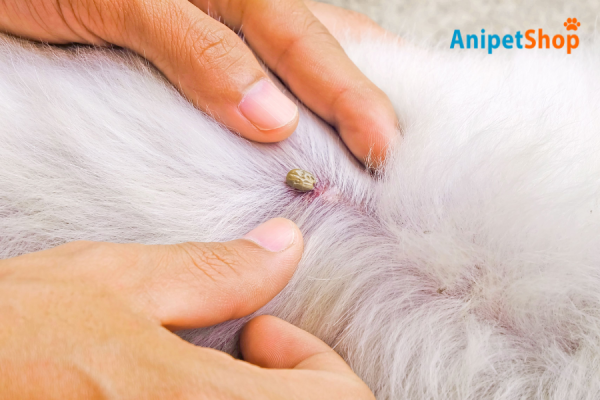
Discovering a tick on your dog can be concerning, but it’s important not to panic. Prompt and safe removal of the tick is crucial. Here’s what you should do if you find a tick:
Remain calm and reassure yourself:
- Feeling alarmed when finding a tick on your dog is natural, but staying calm is essential. Panicking may lead to hasty or improper removal, increasing the risk of leaving mouthparts behind.
- Remember that ticks are common parasites, and prompt removal is highly effective in preventing tick-borne diseases.
Safely remove the tick:
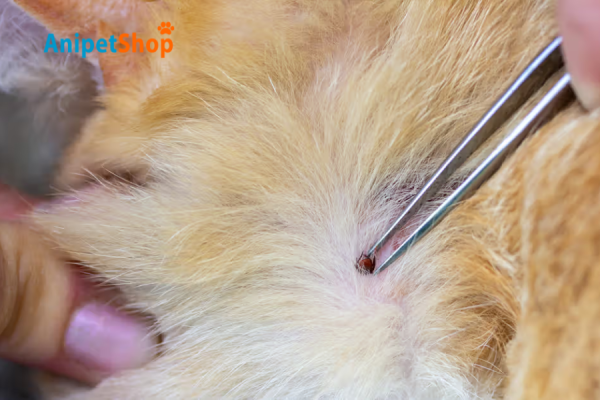
- Use fine-tipped tweezers specifically designed for tick removal or a tick removal tool. Grasp the tick as close to the skin as possible, ensuring a firm grip.
- Gently pull the tick straight out with steady pressure. Avoid twisting or jerking motions, as this can cause the tick’s mouthparts to break off and remain in the skin.
- After removal, disinfect the area with rubbing alcohol.
- For detailed instructions on the safe removal of ticks, I recommend visiting a dedicated resource or referring to another trusted article that provides step-by-step guidance. [Include a hyperlink to a reliable source or article on tick removal.]
Consider saving the tick and contacting your veterinarian:
- If possible, save the removed tick in a small container with a secure lid. Label it with the date and location where it was found.
- Contact your veterinarian and inform them about the tick. They can guide whether to bring the tick in for identification or testing.
- Certain ticks carry specific diseases, and identifying the tick species may help determine the risk to your dog’s health. Your veterinarian can offer appropriate advice based on the region and tick species involved.
Remember, monitoring your dog for any signs of illness or unusual symptoms following a tick bite is essential. If you notice any concerning changes in your dog’s behavior or health, consult your veterinarian promptly. Following these steps, you can safely remove a tick from your dog and take appropriate measures to address any potential risks associated with tick-borne diseases.
Conclusion:
Regularly checking your dog for ticks is vital to their overall health care. By following this step-by-step guide, you can effectively find ticks on your dog, ensuring their well-being and reducing the risk of tick-borne diseases. Remember to perform tick checks after outdoor activities, especially in areas where ticks are prevalent. Your diligent efforts will go a long way in keeping your beloved pet safe and healthy.
FAQs
What is the easiest way to check a dog for ticks?
The easiest way to check a dog for ticks is to physically examine their entire body, running your hands through their fur and feeling for any small bumps or irregularities. Pay close attention to common areas where ticks are often found, such as the ears, face, neck, armpits, between the toes, groin, and tail. Combining the tactile examination with a visual inspection can help ensure a thorough check for ticks.
Where is the most common place to find ticks on a dog?
Ticks can be found anywhere on a dog’s body, but there are certain areas where they are commonly found. The most common places to find ticks on a dog include the ears (inner folds and behind the ears), around the eyes and face, under the collar or harness, under the front legs (armpits), between the toes (including paw pads), and around the groin and tail area.
How will I know if my dog has a tick?
Ticks can appear as small, dark, or irregularly shaped objects attached to the skin. They may be partially or fully embedded in the skin and can vary in size depending on their life stage and whether they have been fed. Additionally, you might notice a tick bite site characterized by a small red bump or irritation on your dog’s skin. Regularly checking your dog for ticks and being aware of any changes in their behavior or health can help you identify if your dog has a tick.
What kills ticks on dogs immediately?
As for products that kill ticks on dogs immediately, NexGard is a popular option. It is an oral medication that kills ticks within 24 hours of administration. When administered to dogs, it kills ticks by disrupting their nervous system, ultimately leading to death. Anipetshop offers several effective products for killing ticks on dogs, including NexGard and Bravecto, known for their immediate action against ticks.
Lily Watson is an author specializing in veterinary care in Australia. With a profound passion for animal welfare and a solid foundation in veterinary science, Lily has dedicated herself to disseminating valuable knowledge and information for both pet owners and professionals in this field.

